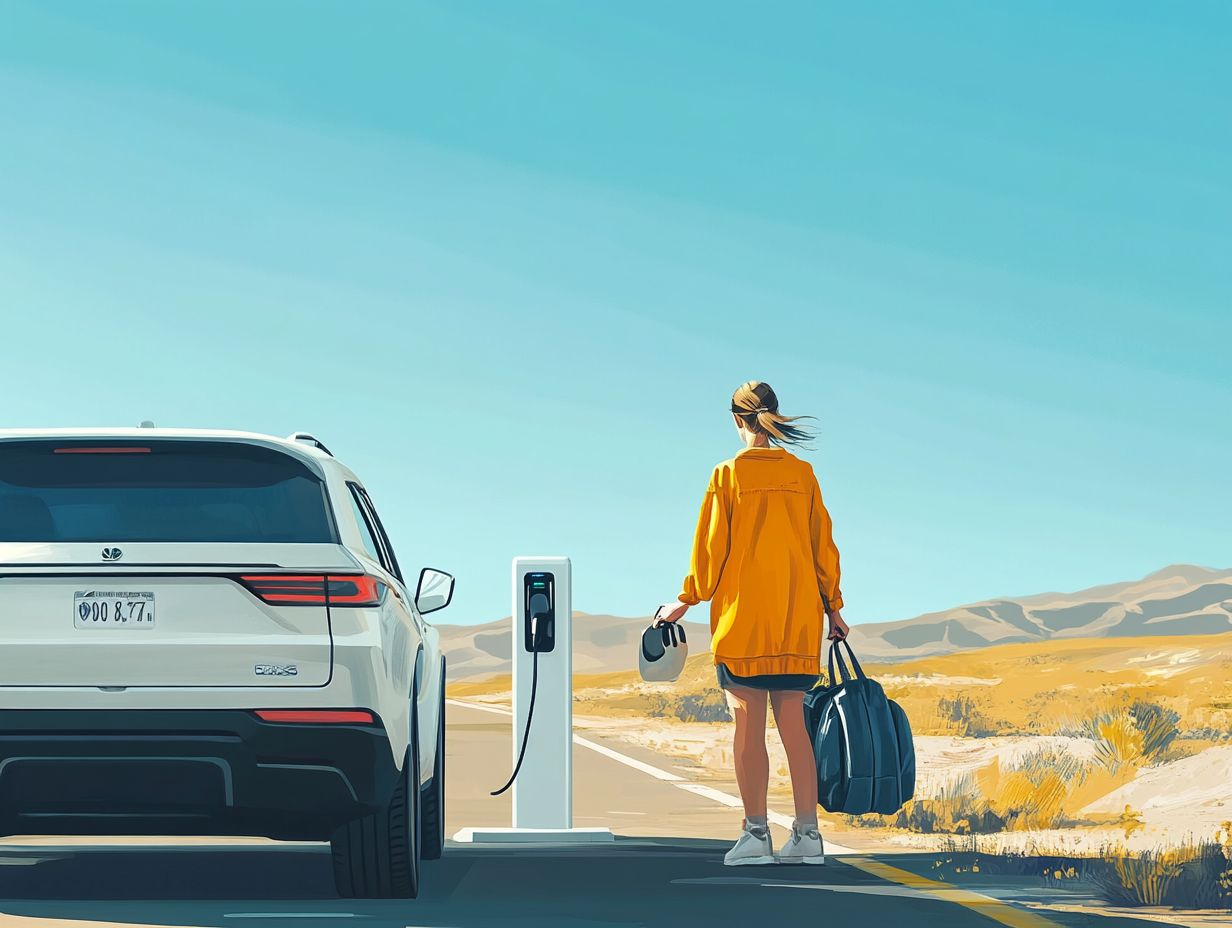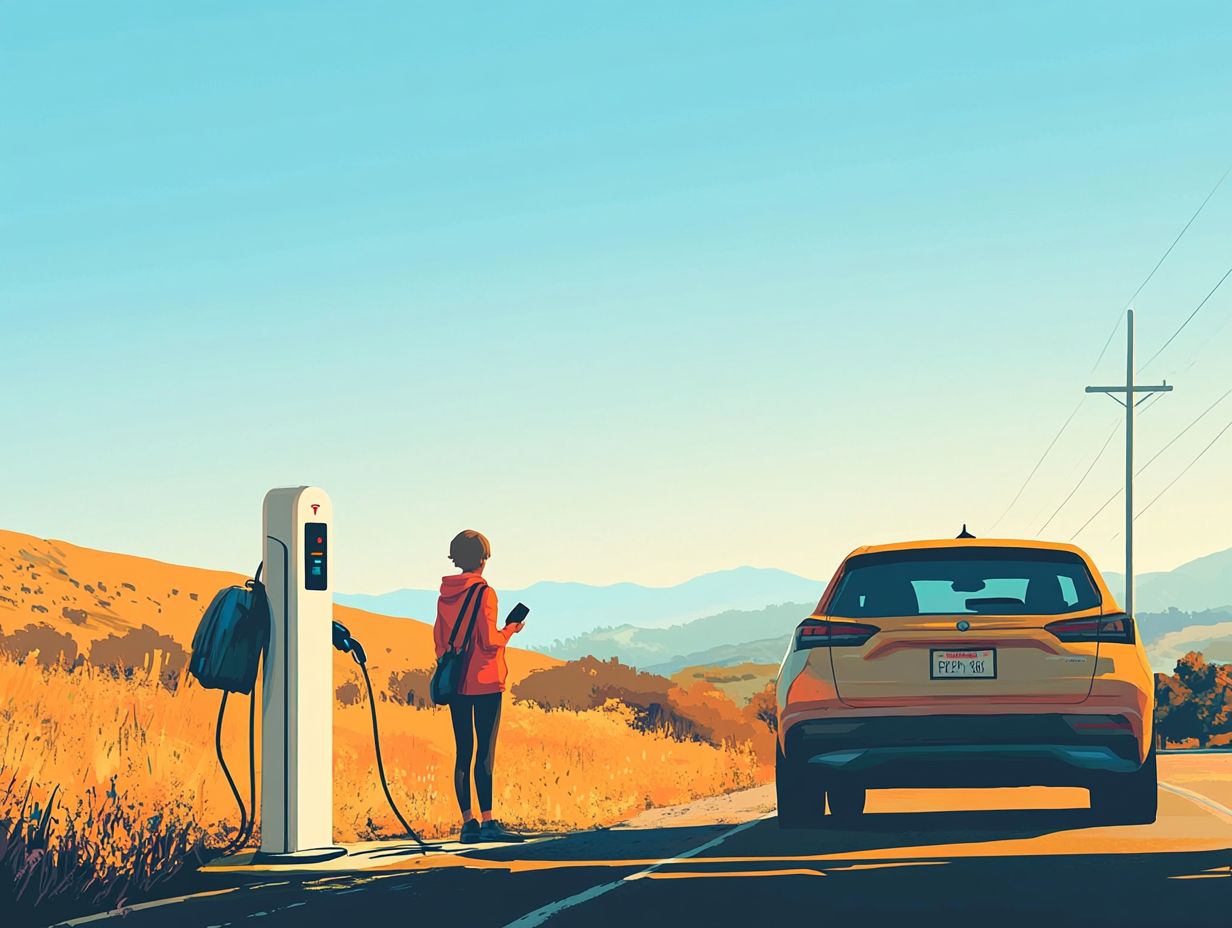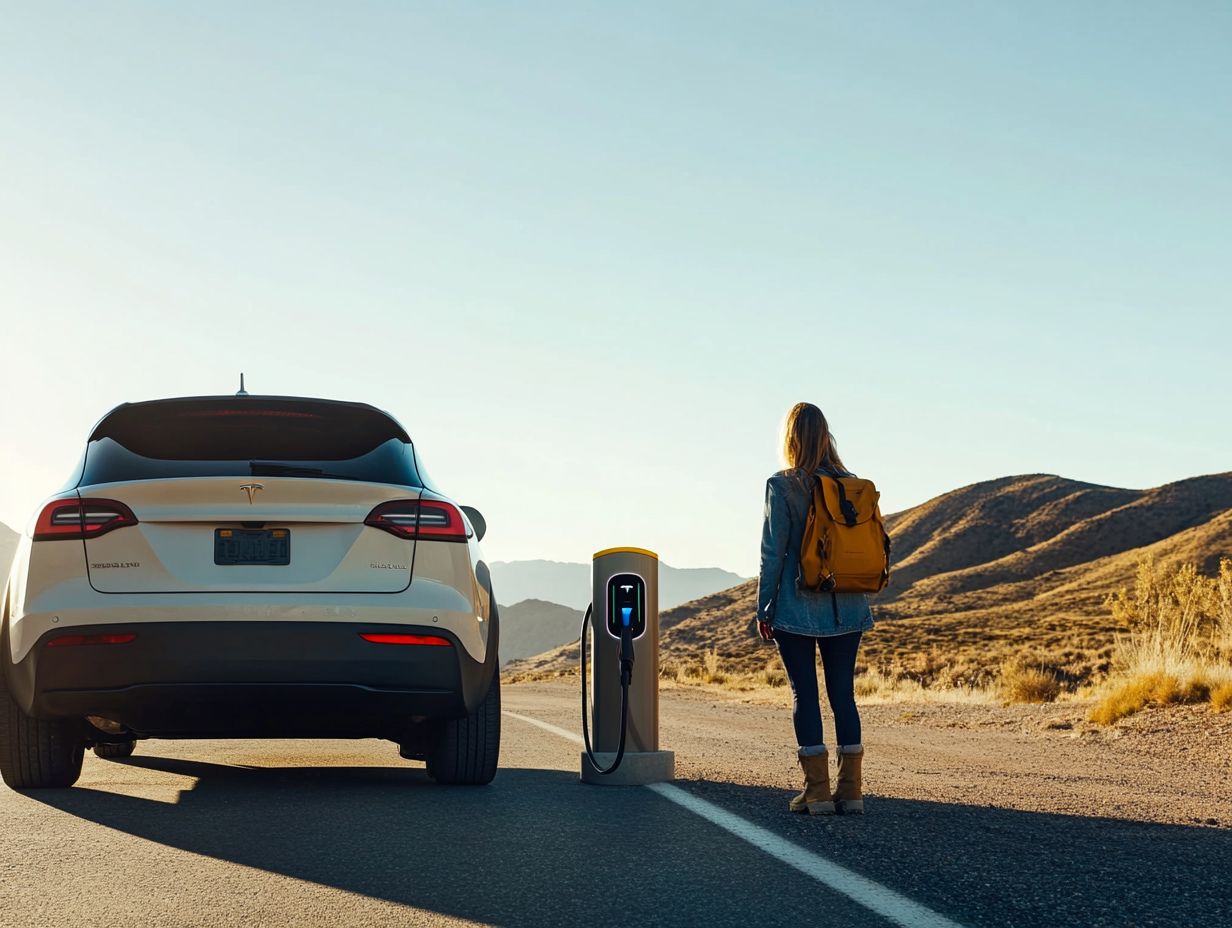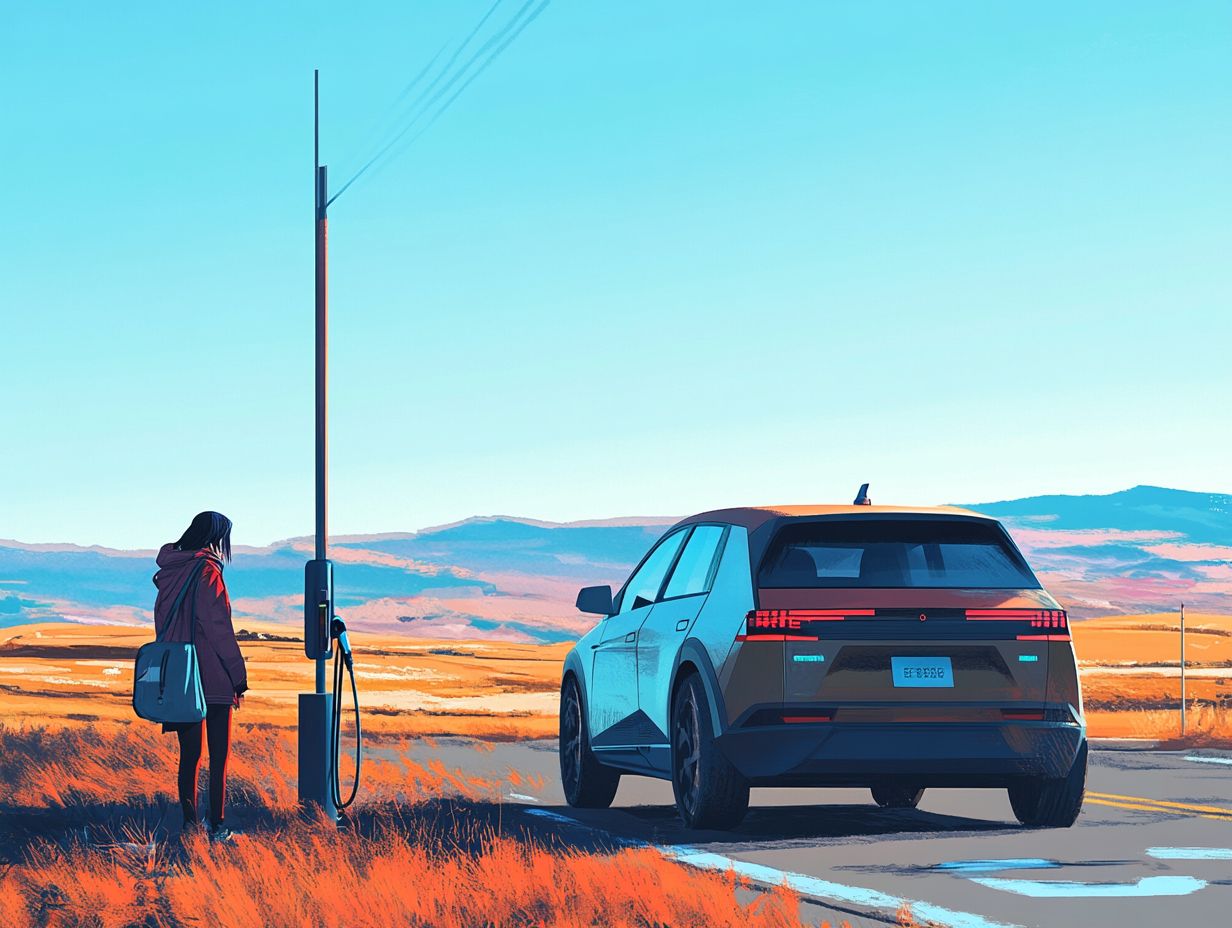preparing your ev for long trips
Planning a long journey with your electric vehicle (EV) can be an exhilarating adventure, but it demands thorough preparation.
From verifying that your car has sufficient range and performance to exploring available charging options, there are several vital steps for you to consider. Once you hit the road, maximizing energy efficiency becomes paramount, especially when you encounter unexpected challenges like inclement weather or technical issues.
As you near your destination, think about your final charging and parking strategies. This guide will help you conquer your road trip like a pro and ensure a seamless and enjoyable EV road trip experience.
Contents
- Key Takeaways:
- What to Expect and How to Plan
- Preparing Your EV for the Trip
- Maximizing Efficiency on the Road
- Dealing with Unexpected Situations
- Arriving at Your Destination
- Frequently Asked Questions
- What are some important factors to consider when preparing my EV for a long trip?
- How can I maximize my EV’s battery range for a long trip?
- Do I need to bring any special equipment for my EV on a long trip?
- What should I do if I encounter a charging station that is out of service?
- Is it better to fully charge my EV before a long trip or use fast charging along the way?
- How can I make my long trip in an EV more efficient and eco-friendly?
Key Takeaways:

Plan ahead and research charging options to ensure a smooth and efficient long-distance trip with your EV. To further enhance your travel experience, check out these tips for keeping your EV in top shape. Maximize efficiency by conserving energy and being prepared for unexpected situations such as inclement weather or technical issues. Upon arrival, consider final charging and parking considerations for a hassle-free end to your trip.
What to Expect and How to Plan
When you embark on an exhilarating road trip in your electric vehicle (EV), meticulous planning is essential for a smooth and enjoyable journey.
This entails understanding your EV’s range and pinpointing convenient charging stations. Use charging apps to optimize your stops. Include extra time for charging and delays. This approach makes your road trip smoother and allows you to explore scenic routes without worry.
Preparing Your EV for the Trip
Preparing your electric vehicle for the trip is essential to optimizing battery charge and achieving maximum range. This preparation includes checking tire pressure and ensuring your software is updated. Additionally, consider tips for properly storing your EV when not in use. Familiarize yourself with fast chargers along your route, whether they be Tesla Superchargers, Ionity stations, or other charging networks.
Taking these steps will help you make the most of your travel experience.
Ensuring Adequate Range and Performance
Ensuring your electric vehicle delivers adequate range and performance starts with understanding your model s specific capabilities such as Audi Etron, Ford, Hyundai Ioniq 6, Kia EV6, or Tesla.
Each of these vehicles has distinct range metrics and performance characteristics that will shape your journey. Remember that driving conditions terrain, temperature, and speed are key factors in determining how far an EV can go on a single charge.
For example, the Hyundai Ioniq 6 shines on flat highways, while hilly landscapes can dampen its performance. Cold weather also tends to affect battery performance across all models.
In terms of long-distance travel, charging infrastructure is a game changer. Tesla’s extensive Supercharger network offers convenience that transforms road trip experiences, while the latest Ford models come equipped with fast-charging capabilities that ease your travels.
Understanding these details helps you choose the right vehicle and gives you the power to plan effective and enjoyable road trips.
Charging Options and Planning

A clear understanding of your charging options and effective planning are essential for a successful road trip in your electric vehicle. This greatly influences your ability to access charging stations easily.
Using charging apps like ChargeHub, PlugShare, and Zap Map allows you to locate available charging networks effortlessly.
These apps provide comprehensive information on the types of charging stations available, including Level 1 (basic home chargers), Level 2 (faster public chargers), and DC fast chargers (quick top-ups on the go). Familiarizing yourself with these distinctions can save you precious time, particularly during longer trips.
Charge stations are often conveniently located in public spaces such as shopping centers, hotels, and dedicated charging hubs, making it straightforward to plan your stops.
Collaborating with key entities like network providers enhances charging accessibility and station reliability, ensuring you have the support you need for seamless navigation and timely charging throughout your adventure.
Start your adventure today plan your route and charging stops!
Maximizing Efficiency on the Road
Maximizing your efficiency on the road is crucial for an enjoyable electric vehicle journey. This allows you to truly enjoy the experience while minimizing those pesky charging stops.
You can boost your efficiency by implementing practical strategies. Maintain an optimal speed and use regenerative braking, a feature that helps recharge your battery while slowing down.
Tips for Conserving Energy
Effective strategies for conserving energy while driving can significantly enhance your electric vehicle’s battery performance. This ensures a more efficient journey.
Make simple adjustments to your driving habits. Avoid rapid acceleration and maintain a steady speed to achieve impressive energy savings.
Consider employing gentle braking techniques. Coast to stops rather than abruptly hitting the brakes. This approach aids in regenerative braking and allows energy to flow back into the battery.
Using cruise control on highways helps stabilize your speed and reduces power consumption by effectively managing throttle positions.
Be mindful of your climate control settings. Limiting air conditioning during drives can further reduce the strain on the battery.
By consistently integrating these practices into your daily driving, you extend battery life and enhance overall vehicle effectiveness. This creates a smoother and more sustainable driving experience.
Dealing with Unexpected Situations
Navigating unexpected situations during your electric vehicle road trip requires foresight and meticulous planning. Inclement weather and unpredictable road conditions can greatly influence your journey.
Prepare for challenges ahead of time. This gives you the power to stay in control and adapt seamlessly to any changes that may arise along the way.
Handling Inclement Weather and Road Conditions

Handling inclement weather and challenging road conditions calls for a proactive approach. Safeguarding your safety and your electric vehicle’s performance throughout the journey is essential.
Adjust your driving habits and stay updated on weather forecasts to significantly enhance your EV’s efficiency. To navigate hazardous conditions with confidence, consider the following strategies:
- Reduce your speed.
- Increase following distances.
Wet or icy surfaces can dramatically impact traction, so exercise caution. Take advantage of features like regenerative braking to maintain better control and achieve smoother deceleration.
Ensure your tires are in optimal condition. Their performance directly affects your vehicle’s grip on the road. Remember that colder temperatures can diminish battery efficiency, which may limit your driving range.
Prepare your vehicle for any weather. Stay informed about road conditions for a safer experience while maximizing your electric vehicle’s capabilities.
Addressing Technical Issues while on the Road
Addressing technical issues on the road can feel overwhelming. However, knowing how to troubleshoot common problems and recognizing when to seek roadside assistance is essential for a successful electric vehicle journey.
Familiarize yourself with the EV network for peace of mind as you travel. You may encounter issues like battery malfunctions, charging failures, or unexpected software glitches.
Being aware of how to check battery levels, reset the onboard computer, or locate the nearest charging station can help you avoid unnecessary frustrations.
Sign up for a reliable roadside assistance service. This ensures you can quickly access expert help whenever problems arise. By taking this proactive approach, you equip yourself with the tools needed to navigate potential mishaps, keeping your travel experience smooth and stress-free.
Arriving at Your Destination
Arriving at your destination in an electric vehicle requires thoughtful planning. Focus on final charging and parking arrangements for a seamless conclusion to your journey.
Familiarize yourself with the charging options available at or near your destination. This helps maintain an optimal battery charge and enhances your overall travel experience.
Final Charging and Parking Considerations
Your final charging and parking choices are vital when you reach your destination in an electric vehicle. They influence your convenience and overall travel satisfaction.
Being informed about available charging options and designated parking areas can enhance your experience and help you recharge efficiently.
Before you arrive, research the destination’s charging options. This includes fast chargers and Level 2 stations, which are regular chargers you can find in public areas. Understanding where to park your electric vehicle and being aware of time limits can streamline the entire process.
Imagine pulling up to a charging station close to a cozy caf ! You can grab a coffee while your car gets charged. It s all about making the most of your time.
Cities are now providing dedicated parking spots for electric vehicles. This thoughtful planning reduces hassles and improves access to chargers. It makes a substantial difference, turning what could be a tedious chore into a seamless part of your travel routine.
Frequently Asked Questions
Here are some common questions about preparing your EV for long trips.

What are some important factors to consider when preparing my EV for a long trip?
Some important factors to consider include checking your EV’s battery range, planning your route around charging stations, and making sure your tires are properly inflated.
How can I maximize my EV’s battery range for a long trip?
To get the most out of your EV’s battery, drive at a steady speed and avoid quick starts or stops. Use regenerative braking it helps recharge the battery while you drive!
Do I need to bring any special equipment for my EV on a long trip?
It is recommended to bring a portable EV charger or a charging cable in case of emergency, as well as any adapters for different types of charging stations.
What should I do if I encounter a charging station that is out of service?
If you encounter a charging station that is out of service, use your GPS or an app to locate the nearest working station and adjust your route accordingly. It is also helpful to have a backup plan in case this situation occurs.
Is it better to fully charge my EV before a long trip or use fast charging along the way?
It is recommended to fully charge your EV before a long trip and only use fast charging in case of emergency. Frequent use of fast charging can decrease the lifespan of your EV’s battery.
How can I make my long trip in an EV more efficient and eco-friendly?
You can make your long trip in an EV more efficient and eco-friendly by practicing efficient driving habits, such as maintaining a steady speed, avoiding unnecessary idling, and using regenerative braking. It is also important to properly dispose of any waste and recycle as much as possible while on the trip.
Ready to hit the road? Plan your electric vehicle journey today and enjoy a smooth trip!





